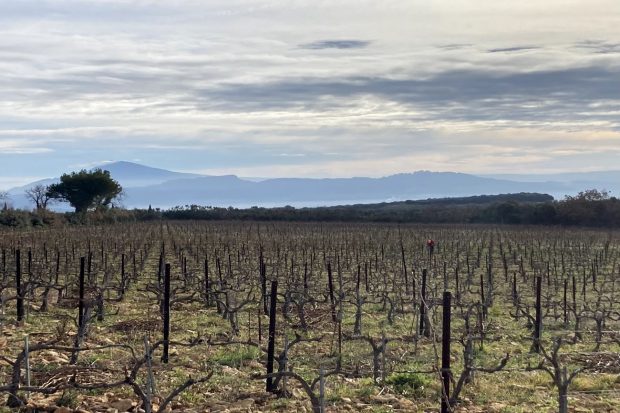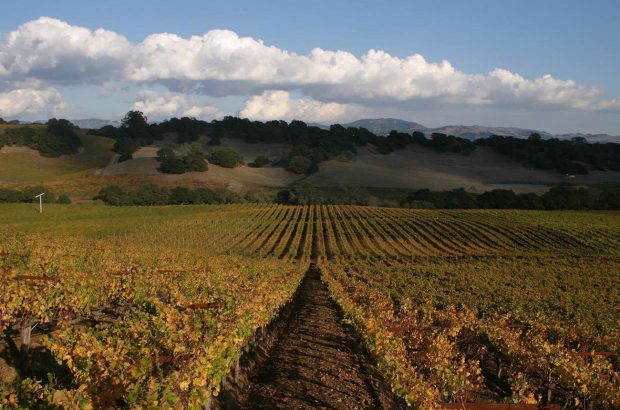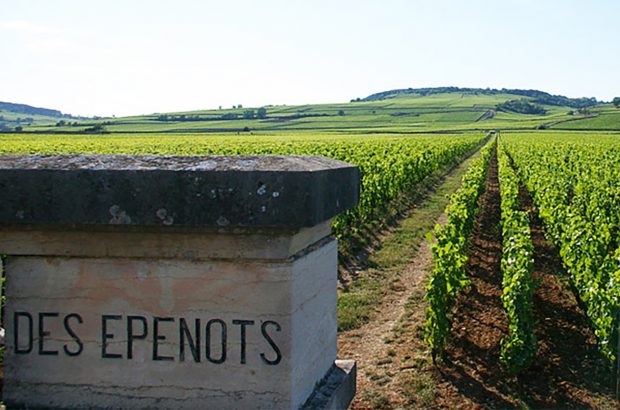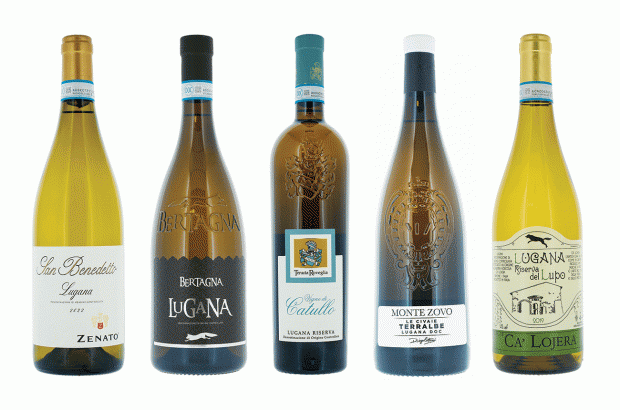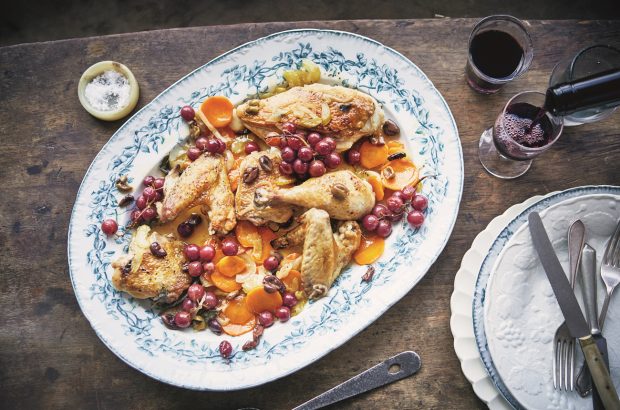Just a few decades on since it was first formally recognised in Chile's vineyards, Carmenere is still asking a lot of questions of the country's wine growers. Peter Richards MW assesses the progress of this enigmatic grape variety
Carmenere in Chile
Area planted (2015) 10,861ha
Percentage of overall Chilean vineyard 8%
Growth in plantings (2005-2015) +58%
Volume produced (2016) 61.2 million litres
Preferred soil types Well-drained with low to moderate fertility
Best-suited climate Warm with moderating influences and a long ripening season
Top producers Caliterra, Carmen, Casa Silva, Concha y Toro, De Martino, Errázuriz, Falernia, J Bouchon, Lapostolle, Pérez Cruz, Tamaya, Terranoble, Undurraga, Ventisquero
-
Scroll down to see wine reviews
In October 2011, a seminal event took place. Held in London, it was a vertical tasting of De Martino’s iconic Carmenere, going back to its very first vintage: 1996. Unexpectedly, the event turned into something of a confessional. Long-term winemaker Marcelo Retamal virtually bared his soul as the elegant early wines veered into super-ripe, powerhouse proportions before the 2010 vintage signalled a return to freshness and purity. ‘I was in a dark place in my winemaking,’ admitted an evidently chastened Retamal at one stage.
Co-owner Sebastian De Martino focused on the bigger picture: ‘The different styles reflect our ambition to discover what we stand for as wine producers. These Carmeneres illustrate the search for our identity.’ Retamal added: ‘More than a tasting of Carmenere, this represents the evolution of the Chilean wine industry. It’s a process; we’ve been learning. Now we see the right way to go.’
Carmenere, it’s fair to say, is a grape variety that provokes a reaction. Often such reactions are conflicted or polarised. Some love it; some hate it; some remain unmoved. In Chile, there are winemakers who consider it at best a bit-part player, good for blending only; others argue strongly that it can stand alone as a terroir-specific, truly noble variety; there are those who say Carmenere can do both. Where most people agree is that Chilean Carmenere remains a work in progress – a fascinating story still in the telling.
Carmenere’s unique history is part of the reason for this. For many years, the variety – closely related to Cabernet Franc – was prized in southwest France, particularly bordeaux, for its deep colour, distinctive aromas and roundness of structure. but then it performed an astonishing vanishing act.
{"content":"PC9wPgo8aDI+TG9zdCBpZGVudGl0eTwvaDI+CjxwPk9uIHRoZSBvbmUgaGFuZCwgQ2FybWVuZXJlIGFsbW9zdCBkaXNhcHBlYXJlZCBmcm9tIGJvcmRlYXV4IGFmdGVyIHBoeWxsb3hlcmEgc3RydWNrIGluIHRoZSBsYXRlLTE5dGggY2VudHVyeS4gRGVzcGVyYXRlIGdyb3dlcnMgd2VyZSByZWx1Y3RhbnQgdG8gcmVwbGFudCBhIGxhdGUtIHJpcGVuaW5nIHZhcmlldHkgcHJvbmUgdG8gdW5yZWxpYWJsZSB5aWVsZHMuIEluIHRoZSBtZWFudGltZSwgaXQgaGFkIGJlZW4gcGxhbnRlZCBlbHNld2hlcmUgaW4gdGhlIHdpbmUtZ3Jvd2luZyB3b3JsZCwgZnJvbSBub3J0aGVybiBJdGFseSB0byBDaGluYS4gTmV3bHkgd2VhbHRoeSBDaGlsZWFucywgZW5yaWNoZWQgYnkgYSBjb21tb2RpdGllcyBib29tLCBoYWQgY29tZSB0byBib3JkZWF1eCBpbiB0aGUgbWlkLTE5dGggY2VudHVyeSBpbiBzZWFyY2ggb2YgdmluZXMgdG8gaW1wcm92ZSB0aGVpciB3aW5lcyBiYWNrIGhvbWUsIGFuZCBDYXJtZW5lcmUgd2FzIHBvcHVsYXIgYW1vbmcgdGhlbS4gSW4gYWxsIHRoZXNlIGxvY2F0aW9ucywgZm9yIHZhcmlvdXMgb2JzY3VyZSByZWFzb25zLCBDYXJtZW5lcmUgc29tZWhvdyBnb3QgbG9zdCBpbiB0aGUgdmFyaWV0YWwgbWl4LiBJbiBJdGFseSwgaXQgYmVjYW1lIGtub3duIGFzIEJsYWNrIEJvcmRlYXV4IG9yIE9sZCBDYWJlcm5ldCwgaW4gQ2hpbmEgYXMgQ2FiZXJuZXQgR2VybmlzY2h0IG9yIFNoZWxvbmd6aHUsIGFuZCBpbiBDaGlsZSBhcyBNZXJsb3QgKG9yIE1lcmxvdCBDaGlsZW5vKS48L3A+CjxwPlRoZSBiaWcgcmV2ZWFsIGRpZG7igJl0IGNvbWUgdW50aWwgMTk5NC4gRnJlbmNoIGFtcGVsb2dyYXBoZXIgSmVhbi1NaWNoZWwgQm91cnNpcXVvdCB3YXMgdmlzaXRpbmcgQ2hpbGUgYW5kIHdhcyBpbnZpdGVkIHRvIGluc3BlY3QgYSBNZXJsb3QgdmluZXlhcmQgb3duZWQgYnkgVmnDsWEgQ2FybWVuLiDigJhJIHdhc27igJl0IGF0IGFsbCBleHBlY3Rpbmcgd2hhdCBoYXBwZW5lZCBuZXh0LOKAmSBleHBsYWlucyBCb3Vyc2lxdW90LCB3aG8gaW1tZWRpYXRlbHkgcmVjb2duaXNlZCB0aGF0IHRoZSB2aW5leWFyZCB3YXNu4oCZdCBNZXJsb3QuIOKAmFRoZSBwcm9ibGVtIHdhcyBpZGVudGlmeWluZyB3aGF0IGl0IHdhczogaXQgb25seSB0b29rIG1lIG9uZSBvciB0d28gbWludXRlcywgYnV0IGl0IHNlZW1lZCBsaWtlIGFuIGV0ZXJuaXR5LuKAmTwvcD4KPHA+RmVsbG93IEZyZW5jaCBhbXBlbG9ncmFwaGVyIENsYXVkZSBWYWxhdCBoYWQgcHJldmlvdXNseSBub3RpY2VkIHRoYXQgdGhlIENoaWxlYW4gTWVybG90IHZpbmV5YXJkIHdhc27igJl0IGVudGlyZWx5IHB1cmUsIGJ1dCBCb3Vyc2lxdW904oCZcyBpbnNwaXJlZCBpZGVudGlmaWNhdGlvbiwgc3Vic2VxdWVudGx5IHByb3ZlbiB2aWEgRE5BIGFuYWx5c2lzLCBsZWQgdG8gbXVjaCBvZiBDaGlsZeKAmXMgTWVybG90IHZpbmV5YXJkIGJlaW5nIHJlY2xhc3NpZmllZCBhcyBDYXJtZW5lcmUg4oCTIGEgcHJvY2VzcyB0aGF0IHJlbWFpbnMgb25nb2luZy4gQXBhcnQgZnJvbSBhbnl0aGluZyBlbHNlLCBpdCBwcm92aWRlZCBhIHJhdGlvbmFsZSBhcyB0byB3aHkgQ2hpbGVhbiDigJhNZXJsb3TigJkgaGFkIHByb3ZlZCBzbyBkaXN0aW5jdGl2ZS48L3A+CjxoMj5Xb3JrIGluIHByb2dyZXNzPC9oMj4KPHA+VGhlIGludGVyaW0geWVhcnMsIGFzIHRoZSBEZSBNYXJ0aW5vIHRhc3Rpbmcgc28gc3RhcmtseSBzaG93ZWQsIGhhdmUgc2VlbiBtdWNoIGRlYmF0ZSBhbmQgYXBwbGllZCByZXNlYXJjaC4gU29tZSB3YW50ZWQgdG8gY2hhbXBpb24gQ2FybWVuZXJlIGFzIGEgcmFsbHlpbmcgcG9pbnQgZm9yIENoaWxlYW4gcHJvZHVjZXJzOiBhIGRpc3RpbmN0aXZlIHZhcmlldHkgdG8gYmUgcHJpb3JpdGlzZWQgYWtpbiB0byBBcmdlbnRpbmHigJlzIE1hbGJlYy4gT3RoZXJzIHVyZ2VkIGNhdXRpb24sIHJlc2VhcmNoIGFuZCBhbiBhY2NlbnQgb24gZGl2ZXJzaXR5IHJhdGhlciB0aGFuIHByaW1hY3kuIEl04oCZcyB0aGUgbGF0dGVyIGFyZ3VtZW50IHRoYXQgaGFzIGxhcmdlbHkgd29uIG91dCBhbmQsIHNsb3dseSwgYSBkaXZlcnNlIHJhbmdlIG9mIHN0eWxlcyBpcyBzdGFydGluZyB0byBlbWVyZ2UgZnJvbSBhY3Jvc3MgdGhlIGNvdW50cnksIGJvdGggaW4gYmxlbmRzIGFuZCBzaW5nbGUtdmFyaWV0YWwgd2luZXMuIFJlc3VsdHMgaGF2ZSBiZWVuIG1peGVkLCBhcyBpcyB0aGUgbmF0dXJlIG9mIGFueSBsZWFybmluZyBjdXJ2ZSwgYnV0IHRoZSB0cmFqZWN0b3J5IG9mIENoaWxlYW4gQ2FybWVuZXJlIGlzIGNlcnRhaW5seSBhbiBpbnRyaWd1aW5nIG9uZS48L3A+CjxwPuKAmFdlIENoaWxlYW5zIHRlbmQgdG8gaHlwZXJ2ZW50aWxhdGUgZWFzaWx5LOKAmSBtdXNlcyBSb2RyaWdvIFNvdG8sIGhlYWQgd2luZW1ha2VyIGF0IFZlcmFtb250ZSwgcmVmZXJyaW5nIHRvIGEgY3VsdHVyYWwgb2JzZXNzaW9uIHdpdGggbm92ZWx0eSwgc3ltcHRvbWF0aWMgb2Ygd2hpY2ggd2FzIHRoZSBpbml0aWFsIGNoYW1waW9uaW5nIG9mIENhcm1lbmVyZSwgc3dpZnRseSBmb2xsb3dlZCBieSBhIHByb2Nlc3Npb24gb2Ygb3RoZXIgdHJlbmR5IHZhcmlldGllcyBpbmNsdWRpbmcgU3lyYWgsIENhcmlnbmFuIGFuZCBQYcOtcy4g4oCYV2UgbmVlZCB0byBiZSB3aXNlcizigJkgaGUgc2F5cywg4oCYYW5kIHRvIHVuZGVyc3RhbmQgd2hlcmUgcmVhbCBxdWFsaXR5IGFuZCBjaGFyYWN0ZXIgY29tZSBmcm9tOiBleHBlcmllbmNlLCBjb25maWRlbmNlLCBnb29kIHZpdGljdWx0dXJhbCBwcmFjdGljZXMg4oCTIGFuZCB0aW1lLuKAmTwvcD4KPHA+VGhlIGluc2lzdGVuY2Ugb24gdGhlIHZpcnR1ZXMgb2YgdGltZSBhbmQgcGF0aWVuY2Ugd2l0aCBDYXJtZW5lcmUgaXMgYSBjb21tb24gdGhlbWUuIFNvdG8gbm90ZXMgaG93IG9sZCB2aW5lcyAoYW5kIHRodXMgcmVzcG9uc2libGUgdml0aWN1bHR1cmUpIGFyZSBuZWVkZWQgdG8gcHJvZHVjZSB0aGUgYmVzdCB3aW5lcy4gVGFtYXlhIG93bmVyIFJlbsOpIE1lcmlubyBpbnNpc3RzOiDigJhDYXJtZW5lcmUgaXMgc3RpbGwgYSB3b3JrIGluIHByb2dyZXNzIOKAkyAyMSB2aW50YWdlcyBpcyBub3QgZW5vdWdoIGluIHdpbmUgeWVhcnMgdG8gc2F5IHdlIGhhdmUgbWFzdGVyZWQgaXQu4oCZIEhlIG5vdGVzIHRoYXQgdGhlIOKAmGJpZ2dlc3QgY2hhbGxlbmdlIGlzIHN0aWxsIGluIHRoZSB2aW5leWFyZOKAmSDigJMgaW4gb3RoZXIgd29yZHMsIHVuZGVyc3RhbmRpbmcgd2hlcmUgQ2FybWVuZXJlIHdvcmtzIGJlc3QgYW5kIHdoeSwgYW5kIHRoZW4gaG93IHRvIGNvYXggdGhlIGJlc3Qgd2luZSBmcm9tIGl0LiDigJhJIGJlbGlldmUgQ2FybWVuZXJlIGlzIHRoZSBtb3N0IGRpZmZpY3VsdCB2YXJpZXR5IHRvIG1ha2UgaW4gQ2hpbGUs4oCZIHBvbmRlcnMgUmV0YW1hbC4g4oCYSXQgbWF5IHRha2UgYSBnZW5lcmF0aW9uYWwgY2hhbmdlIHRvIHVuZGVyc3RhbmQgaXQgcHJvcGVybHku4oCZPC9wPgo8ZGl2IGlkPSJhdHRhY2htZW50XzM2NDQ2OSIgc3R5bGU9IndpZHRoOiA2NjBweCIgY2xhc3M9IndwLWNhcHRpb24gYWxpZ25jZW50ZXIiPjxpbWcgYXJpYS1kZXNjcmliZWRieT0iY2FwdGlvbi1hdHRhY2htZW50LTM2NDQ2OSIgY2xhc3M9Imxhenlsb2FkIGJsdXItdXAgd3AtaW1hZ2UtMzY0NDY5IHNpemUtZnVsbCIgc3JjPSJodHRwczovL3d3dy5kZWNhbnRlci5jb20vd3AtY29udGVudC90aGVtZXMvc2ltYmEtdGhlbWUvYXNzZXRzL2ltYWdlcy9wbGFjZWhvbGRlci5wbmciIGRhdGEtc3JjPSJodHRwczovL2tleWFzc2V0cy50aW1laW5jdWsubmV0L2luc3BpcmV3cC9saXZlL3dwLWNvbnRlbnQvdXBsb2Fkcy9zaXRlcy8zNC8yMDE3LzAzL0Nhcm1lbmVyYS1Sb2RyaWdvLVNvdG8uanBnIiBhbHQ9IlJvZHJpZ28gU290bywgQ2FybWVuZXJhIiB3aWR0aD0iNjUwIiBoZWlnaHQ9IjQzMCIgZGF0YS1zaXplcz0iYXV0byIgZGF0YS1zcmNzZXQ9Imh0dHBzOi8va2V5YXNzZXRzLnRpbWVpbmN1ay5uZXQvaW5zcGlyZXdwL2xpdmUvd3AtY29udGVudC91cGxvYWRzL3NpdGVzLzM0LzIwMTcvMDMvQ2FybWVuZXJhLVJvZHJpZ28tU290by5qcGcgNjUwdywgaHR0cHM6Ly9rZXlhc3NldHMudGltZWluY3VrLm5ldC9pbnNwaXJld3AvbGl2ZS93cC1jb250ZW50L3VwbG9hZHMvc2l0ZXMvMzQvMjAxNy8wMy9DYXJtZW5lcmEtUm9kcmlnby1Tb3RvLTEzNXg4OS5qcGcgMTM1dywgaHR0cHM6Ly9rZXlhc3NldHMudGltZWluY3VrLm5ldC9pbnNwaXJld3AvbGl2ZS93cC1jb250ZW50L3VwbG9hZHMvc2l0ZXMvMzQvMjAxNy8wMy9DYXJtZW5lcmEtUm9kcmlnby1Tb3RvLTMwMHgxOTguanBnIDMwMHcsIGh0dHBzOi8va2V5YXNzZXRzLnRpbWVpbmN1ay5uZXQvaW5zcGlyZXdwL2xpdmUvd3AtY29udGVudC91cGxvYWRzL3NpdGVzLzM0LzIwMTcvMDMvQ2FybWVuZXJhLVJvZHJpZ28tU290by02MzB4NDE3LmpwZyA2MzB3LCBodHRwczovL2tleWFzc2V0cy50aW1laW5jdWsubmV0L2luc3BpcmV3cC9saXZlL3dwLWNvbnRlbnQvdXBsb2Fkcy9zaXRlcy8zNC8yMDE3LzAzL0Nhcm1lbmVyYS1Sb2RyaWdvLVNvdG8tMzIweDIxMi5qcGcgMzIwdywgaHR0cHM6Ly9rZXlhc3NldHMudGltZWluY3VrLm5ldC9pbnNwaXJld3AvbGl2ZS93cC1jb250ZW50L3VwbG9hZHMvc2l0ZXMvMzQvMjAxNy8wMy9DYXJtZW5lcmEtUm9kcmlnby1Tb3RvLTYyMHg0MTAuanBnIDYyMHciIHNpemVzPSIobWF4LXdpZHRoOiA2NTBweCkgMTAwdncsIDY1MHB4IiAvPjxwIGlkPSJjYXB0aW9uLWF0dGFjaG1lbnQtMzY0NDY5IiBjbGFzcz0id3AtY2FwdGlvbi10ZXh0Ij5Sb2RyaWdvIFNvdG88L3A+PC9kaXY+CjxoMj5CcmFuY2hpbmcgb3V0PC9oMj4KPHA+Rm9yIHNvbWUgdGltZSBpbiBDaGlsZSwgaXQgc2VlbWVkIGFzIGlmIHRoZXJlIHdlcmUgb25seSB0d28gc3R5bGlzdGljIHBhcmFkaWdtcyBmb3IgQ2FybWVuZXJlLiBPbmUgd2FzIHVucmlwZSBhbmQgdmlydWxlbnRseSBncmVlbi4gVGhlIG90aGVyIHdhcyByaWNoLCBvcHVsZW50LCBidXhvbTogYSB3aW5lIG9mIG91dHJhZ2VvdXMgY3VydmVzIGFuZCBib3VudGlmdWwgc3BsZW5kb3Vycy4gTm93YWRheXMsIHRoYXQgcGljdHVyZSBpcyBiZWNvbWluZyBpbmNyZWFzaW5nbHkgbnVhbmNlZCBhcyB3ZSBzZWUgQ2FybWVuZXJlcyBtYWpvcmluZyBvbiBuYXR1cmFsIHNjZW50LCBjb21wbGV4aXR5IGFuZCB0ZW5zaW9uLCByYXRoZXIgdGhhbiBiZWluZyBoYXJ2ZXN0ZWQgdW5yaXBlIG9yIHJlbHlpbmcgb24gY29udHJpdmVkIGhlZnQuIFRoZXJlIGlzIG1vcmUgdmFyaWV0YWwgY2hhcmFjdGVyIGluIGV2aWRlbmNlIGFuZCBsZXNzIG92ZXJ0IHdpbmVtYWtpbmcgaW50ZXJ2ZW50aW9uIHN1Y2ggYXMgaGVhdnkgZXh0cmFjdGlvbiBvciBuZXcgb2FrLjwvcD4KPHA+Q3J1Y2lhbCB3aXRoaW4gdGhpcyBldm9sdXRpb25hcnkgcHJvY2VzcyBoYXMgYmVlbiB0aGUgZm9jdXMgb24gdGVycm9pci48L3A+CjxwPlRha2UgY2xpbWF0ZS4gSW5pdGlhbGx5LCBpdCB3YXMgYXNzdW1lZCB0aGF0LCBiZWNhdXNlIENhcm1lbmVyZSBpcyBhIG5hdHVyYWxseSBsYXRlLXJpcGVuaW5nIHZhcmlldHksIGl0IG5lZWRlZCB0aGUgd2FybWVzdCBzaXRlcy4gWWV0IHRoZXNlLCBlc3BlY2lhbGx5IGluIHdhcm0gdmludGFnZXMsIGNhbiBwcm9kdWNlIGV4Y2Vzc2l2ZWx5IGFsY29ob2xpYywgb3ZlcnJpcGUgc3R5bGVzLiBOb3csIHdpbmUtZ3Jvd2VycyB0ZW5kIHRvIHNlZWsgb3V0IHdhcm0gY2xpbWF0ZXMgYnV0IHdpdGggbW9kZXJhdGluZyBpbmZsdWVuY2VzLCBpbiBvcmRlciB0byByZXRhaW4gZnJlc2huZXNzIGFuZCB2YXJpZXRhbCBwdXJpdHkgd2hpbGUgbWluaW1pc2luZyB0aGUgcmlzayBvZiBsYXRlLXNlYXNvbiByYWluLjwvcD4KPHA+T25lIGV4YW1wbGUgb2YgdGhpcyBpcyBDYXNhIFNpbHZh4oCZcyBMb3MgTGluZ3VlcyBlc3RhdGUgaW4gdGhlIGZvb3RoaWxscyBvZiB0aGUgQW5kZXMsIHdoZXJlaW4gQ29sY2hhZ3Vh4oCZcyB3YXJtIGNsaW1hdGUgaXMgdGVtcGVyZWQgYnkgY29vbGluZyBtb3VudGFpbiBicmVlemVzLCBwcm9kdWNpbmcgbmF0dXJhbGx5IGJhbGFuY2VkIHdpbmVzLiDigJhJZiB5b3UgcGxhbnQgaW4gdGhlIHJpZ2h0IHBsYWNlIGxpa2UgTG9zIExpbmd1ZXMsIHlvdSBjYW4gZ2V0IENhcm1lbmVyZSB0aGF0IGlzIGJvdGggcmlwZSBhbmQgZnJlc2gsIHdpdGggdGhlIHNwaWN5IGFyb21hcyBhbmQgZmxhdm91cnMgdGhhdCBhcmUgcGFydCBvZiBpdHMgRE5BLOKAmSBjb21tZW50cyBNYXJpbyBQYWJsbyBTaWx2YS48L3A+CjxwPlNpbWlsYXJseSwgbXVjaCBkZWJhdGUgaGFzIGNlbnRyZWQgb24gdGhlIGNvcnJlY3Qgc29pbHMgZm9yIENhcm1lbmVyZS4gVGhlIG9yaWdpbmFsIHRoaW5raW5nIHdhcyB0aGF0IGRlZXAgYWxsdXZpYWwgc29pbHMgb24gdmFsbGV5IGZsb29ycyB3b3JrZWQgYmVzdDogZm9yIGdvb2QgZHJhaW5hZ2UgYnV0IHdpdGggc29tZSBjbGF5IGhlbHBpbmcgdG8gcmV0YWluIG1vaXN0dXJlLCBlbmFibGluZyB0aGUgdmluZXMgdG8gY29udGludWUgZnVuY3Rpb25pbmcgdW50aWwgbGF0ZSBpbiB0aGUgc2Vhc29uLiBZZXQgc29tZSBleGNlbGxlbnQgQ2FybWVuZXJlcyBhcmUgbm93IGVtZXJnaW5nIGZyb20gZGVjaWRlZGx5IGRpZmZlcmVudCBzb2lsIHR5cGVzIGFsbCBhY3Jvc3MgdGhlIGNvdW50cnksIGluY2x1ZGluZyB0aGluLCBkZWdyYWRlZCBncmFuaXRpYyBzb2lscyBvbiBoaWxsc2lkZXMuIFRoaXMgaXMgYm9vc3RpbmcgZGl2ZXJzaXR5IGFuZCBjaGFsbGVuZ2luZyBwcmVjb25jZXB0aW9ucyBpbiBtb3N0IHdlbGNvbWUgZmFzaGlvbi4gVGhlIG9uZSBjb25zZW5zdXMgaXMgdGhhdCBDYXJtZW5lcmUgZG9lc27igJl0IHdvcmsgaW4gZmVydGlsZSBzb2lscywgd2hpY2ggcHJvZHVjZSBleGNlc3NpdmUgY2Fub3BpZXMgYW5kIHVucmlwZSBmcnVpdC4gQmV5b25kIHRoaXMsIGl04oCZcyBhbGwgdG8gcGxheSBmb3IuIOKAmFdpdGggQ2FybWVuZXJlLCB5b3UgY2FuIGdldCBncmVhdCB3aW5lIG9mZiBhIGdyZWF0IHNpdGUsIGJ1dCBmb3Igb3RoZXIgc2l0ZXMgaXTigJlzIGp1c3Qgbm90IHdvcnRoIGl0IOKAkyB0aGVyZeKAmXMgbm8gcG9pbnQgZm9yY2luZyBuYXR1cmUs4oCZIHNheXMgQ29uY2hhIHkgVG9yb+KAmXMgTWFyY2VsbyBQYXBhLjwvcD4KPGgyPkFsbCB0byBwbGF5IGZvcjwvaDI+CjxwPkNvbGNoYWd1YSBhbmQgQ2FjaGFwb2FsIHJlbWFpbiB0aGUgaGVhcnRsYW5kcyBmb3IgQ2FybWVuZXJlIGluIENoaWxlLCBidXQgdGhpcyBwaWN0dXJlIGxvb2tzIHNldCB0byBkaXZlcnNpZnkgYXMgdGhlIGxpa2VzIG9mIE1haXBvLCBBY29uY2FndWEsIExpbWFyw60gYW5kIEVscXVpIHRvIHRoZSBub3J0aCwgYW5kIEN1cmljw7MgYW5kIE1hdWxlIHRvIHRoZSBzb3V0aCBhbGwgbWFrZSBzdWNjZXNzZnVsIENhcm1lbmVyZSBpbiBhIHJhbmdlIG9mIHN0eWxlcy4gR2l2ZW4gQ2hpbGXigJlzIG5hdHVyYWxseSBwcm9saWZpYyBkaXZlcnNpdHkgb2Ygc29pbHMgYW5kIGNsaW1hdGVzLCBpdOKAmXMganVzdCBhcyBtdWNoIGFib3V0IGluZGl2aWR1YWwgc2l0ZXMgYW5kIGdyb3dlcnPigJkgYXBwcm9hY2hlcyBhcyBpdCBpcyB0aGUgYnJvYWRlciByZWdpb25zLjwvcD4KPHA+QSBzaW1pbGFyIGxvZ2ljIGFwcGxpZXMgdG8gdGhlIGJsZW5kaW5nIHZlcnN1cyBzb2xvIHZhcmlldGFsIGFyZ3VtZW50LiBJZiBDYXJtZW5lcmUgY2FuIGJlIHNhaWQgdG8gaGF2ZSB0d28ga2V5IG5hdHVyYWwgc3RhdGVzLCB0aGV5IHdvdWxkIGJlIGVpdGhlciBhIGxlYWZ5LCByZWZyZXNoaW5nIGFuZCByZXN0cmFpbmVkIHN0eWxlLCBvciB0aGUgb25lIChtb3JlIGNvbW1vbmx5IGZvdW5kKSB0aGF0IGVycnMgb24gdGhlIHNpZGUgb2YgcGx1c2huZXNzLCBzdWNjdWxlbmNlIGFuZCBpbmt5IGRhcmsgZnJ1aXQuIEJvdGggcmVuZGl0aW9ucywgc29tZSB3aW5lbWFrZXJzIGFyZ3VlLCBiZW5lZml0IGZyb20gYmxlbmRpbmcg4oCTIGVpdGhlciB0byBmbGVzaCB0aGluZ3Mgb3V0IG9yIHRvIHByb3ZpZGUgYmFja2JvbmUgYW5kIHN0cnVjdHVyZSDigJMgd2l0aCBDYWJlcm5ldCBTYXV2aWdub24gYmVpbmcgdGhlIG1vc3QgY29tbW9uIGJsZW5kaW5nIHBhcnRuZXIsIGJ1dCB0aGUgbGlrZXMgb2YgU3lyYWgsIE1lcmxvdCBhbmQgZXZlbiBQYcOtcyBhbmQgQ2FyaWduYW4gYWxzbyBwcm92aWRpbmcgZWZmZWN0aXZlIGNvbXBsZW1lbnRzLjwvcD4KPHA+T3RoZXJzIG1haW50YWluIHRoYXQgQ2FybWVuZXJlIGNhbiBzdGFuZCBhbG9uZSDigJMgYW5kIHRoZXJlIGFyZSBhbHJlYWR5IHNvbWUgZ3JlYXQgQ2hpbGVhbiB3aW5lcyBpbiBleGlzdGVuY2UgdG8gZGVtb25zdHJhdGUgdGhpcyDigJMgYnV0IHRoYXQgaXRzIHRydWUgcG90ZW50aWFsIHdpbGwgb25seSBiZWNvbWUgY2xlYXIgYXMgdGhlIHZhcmlldHkgY29udGludWVzIHRvIGJlIGJldHRlciB1bmRlcnN0b29kLjwvcD4KPGRpdiBjbGFzcz0iaW5qZWN0aW9uIj48L2Rpdj4KPHA+VGltZSB3aWxsIHRlbGwuIEFzIFJldGFtYWwgY29tbWVudHM6IOKAmFdoZW4gaXQgY29tZXMgdG8gQ2FybWVuZXJlLCB5b3UgY2Fu4oCZdCBydWxlIGFueXRoaW5nIG91dC7igJkgSW4gdGhlIG1lYW50aW1lLCBDYXJtZW5lcmUgY2FuIGJlIGVuam95ZWQgaW4gYW4gaW5jcmVhc2luZ2x5IGltcHJlc3NpdmUgcmFuZ2Ugb2Ygc3R5bGVzIGFuZCBmb3JtYXRzIOKAkyBvbmUgY29uY2x1c2lvbiBmcm9tIHRoZSAyMDE2IERlY2FudGVyIFdvcmxkIFdpbmUgQXdhcmRzIChvZiB3aGljaCBJIGFtIFJlZ2lvbmFsIENoYWlyIGZvciBDaGlsZSkgd2FzIHRoYXQgQ2FybWVuZXJlIGlzIHByb2R1Y2luZyBiZXR0ZXIgYW5kIG1vcmUgY29uc2lzdGVudCB3aW5lcywgYWNyb3NzIGEgcmFuZ2Ugb2Ygc3R5bGVzLCB0aGFuIGl0IGV2ZXIgaGFzIGJlZm9yZS48L3A+CjxwPk9uZSB0aGluZ+KAmXMgZm9yIHN1cmU6IGdpdmVuIHRoZSBpbnRyaWd1aW5nIHR3aXN0cyBhbmQgdHVybnMgaW4gaXRzIGhpc3RvcnkgdG8gZGF0ZSwgaXTigJlzIGEgYnJhdmUgZHJpbmtlciB3aG8gY29uc2lkZXJzIENhcm1lbmVyZeKAmXMgZnV0dXJlIGVhc2lseSBwcmVkaWN0YWJsZS48L3A+CjxwPsKgPC9wPgo8cD4K"}
Richards’ pick of Chilean Carmenere:
{}
{"wineId":"23279","displayCase":"standard","paywall":true}
{"wineId":"23281","displayCase":"standard","paywall":true}
{"wineId":"23282","displayCase":"standard","paywall":true}
{"wineId":"23283","displayCase":"standard","paywall":true}
{"wineId":"23284","displayCase":"standard","paywall":true}
{"wineId":"23285","displayCase":"standard","paywall":true}
{"wineId":"23286","displayCase":"standard","paywall":true}
{"wineId":"23287","displayCase":"standard","paywall":true}
{"wineId":"23288","displayCase":"standard","paywall":true}
{"wineId":"23289","displayCase":"standard","paywall":true}
{"wineId":"23290","displayCase":"standard","paywall":true}
{}






